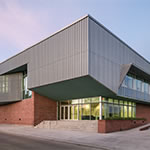This article is an excerpt from New Orleans: Structure, Community, City. Find it at the Greenbuild Bookstore or contact Jen Illescas at [email protected]/magazine.
–
Although New Orleans isn’t thought of as a college town, Tulane University is widely considered one of the city’s top economic drivers, employers, and trendsetters. As a hub of rebuilding, revitalizing, and entrepreneurship, Tulane has a story that mirrors its hometown’s. The university has committed to achieving LEED Silver standards in all new buildings and will be carbon neutral by 2030—goals that are being driven by a panel of university employees known as the Green Machine.
Below, take a tour of Tulane’s greenest buildings, from a renovated 90-year-old academic building to a cutting-edge gymnasium.
The Hertz Center
The $13 million LEED-certified Hertz Center has 43,000 square feet of practice space for Tulane’s men’s and women’s basketball and women’s volleyball teams. The Hertz Center has two courts made of FSC-certified wood; several offices and locker rooms; a conditioning, training, and hydrotherapy center; a film room; and conference rooms for breakout meetings. The design teams at Gould Evans and Lee Ledbetter & Associates envisioned the center as a “home away from home” for student athletes and included areas for them to relax outside when off the courts, complete with iPod and iPhone docking stations.



Dinwiddie Hall
Renovated in 2010, the 91-year-old Dinwiddie Hall achieved LEED Gold status after the Green Machine chose it to be the first LEED project on campus. Dinwiddie was renovated for $9 million and currently houses the Department of Anthropology and the Middle American Research Institute. The project focused on recycling and preserving materials and maintained 51 percent of the original interior. More than 76 percent of the demolition and construction waste from the project was recycled. Dinwiddie uses 17.9 percent less energy than a baseline building, and low-flow fixtures have reduced water use by 35 percent. The contractor who worked on Dinwiddie ensured that all paints, primers, sealants, adhesives, and coatings met low-VOC standards, and the building is equipped with carbon dioxide monitors.



J. Bennett Johnston Health and Environmental Research Building
Greening a research facility is never easy, but the three-floor laboratory renovation of the seven-story J. Bennett Johnston Health and Environmental Research Building achieved LEED-CI Gold certification after its completion in August 2013. The old model consisted of small individual rooms, which were converted into ballroom-style laboratory spaces, which are open and collaborative instead of closed off. The building’s low-flow plumbing fixtures are estimated to reduce water consumption by more than 30 percent, and 54 percent of the existing materials remained in the renovated space. Laboratories consume much more energy than other university buildings, especially because of the need for fume hoods to clean the air. Variable airflow fume hoods were installed to reduce the necessary amount of conditioned air, and the laboratory’s lighting fixtures are tailored to each workspace and turn off automatically when the room is empty or can be lit by sunlight.



Weatherhead Hall
Construction of Weatherhead Hall, the 80,700-square-foot home to more than 260 undergraduate students, was scheduled to begin the day Hurricane Katrina hit the Gulf region. Following the disaster, the teams at Hanbury Evans Wright Vlattas Architects and John C. Williams Architects updated the design with new building codes, improved flood-mitigation techniques, and set a goal to achieve LEED certification upon completion in 2011. Occupancy sensors, the most noticeable green feature, were employed to shut off lights in hallways, stairwells, and unused rooms. The sensors also control temperature and select electrical outlets throughout the building. The university’s first dual-flush toilets were installed in Weatherhead, which is predicted to reduce water use by 32 percent.



—
Want to learn more about Tulane University’s sustainability efforts? Read our Q&A with sustainability director Liz Davey here.

